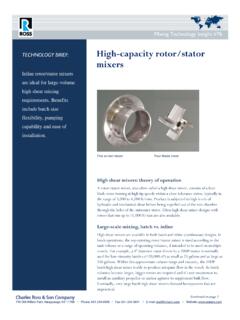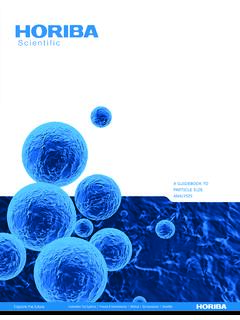Transcription of A GUIDE TO UNDERSTANDING AND MIXING THICKENERS - …
1 A GUIDE TO UNDERSTANDING AND MIXING THICKENERS Rheology modifiers, commonly referred to as THICKENERS or viscosifiers, are ever-present in most products. The use of these additives cut across several process industries including food, pharmaceuticals, cosmetics and personal care, adhesives, textile, ceramics, paper, detergents, paints, inks and coatings, among others. They serve the purpose of not just altering the viscosity of the formulation but also that of providing specific functionality to the product. This could range from improving mouthfeel, body, texture, moisture retention and suspendability of soluble ingredients to increasing stability and dry strength, inhibiting syneresis, resisting bacterial attack, preventing shrinkage and controlling crystal ice formation.
2 THICKENERS come from both natural and synthetic sources. Naturally occurring polymers comprised of polysaccharide or amino acid building blocks, and are generally water-soluble. common examples are starch, cellulose, alginate, egg yolk, agar, arrowroot, carageenan, collagen, gelatin, guar gum, pectin and xanthan gum. On the other side, synthetic acrylic-based polymers are conveniently grouped into three general classes: alkali-swellable (or soluble) emulsions (ASE s) hydrophobically modified alkali-swellable emulsions (HASE s) and hydrophobically modified, ethoxylated urethane resins (HEUR s).
3 HASE s are modifications of ASE s following an addition of hydrophobic functional groups. These are commonly known as associative THICKENERS . In its simplest form, an associative thickener is a water-soluble polymer containing several relatively hydrophobic groups. HEUR s also belong to the category of associative THICKENERS . But unlike HASE s, HEUR s are nonionic substances and are not dependent on alkali for activation of the thickening mechanism. Typically in the form of white, fluffy, dry powder, popular varieties of synthetic THICKENERS include carbomers, sodium carboxymethylcellulose (CMC) and fumed silica.
4 THE PLOT THICKENS Rheology modifiers alter a system s viscosity through a combination of mechanisms. Addition of alkali to an emulsion consisting of tightly coiled polymers generates anionic charges along the chains. Like charges repel each other and the polymers swell and uncoil occupying more volume within the solution. Also, hydrophobic groups form domains along other water-hating groups, ultimately reducing overall free energy and manifesting as a more structured, less fluid system. Lastly, particle-to-particle interactions between thickener and charged surfaces of system components bring about changes in rheological properties.
5 The ease by which THICKENERS are effectively dispersed or dissolved in the solvent chemically depends on particle size, molecular weight and structure (average number and distribution of hydroxyl groups per compound) and also the presence of a surfactant. The primary objectives of the MIXING step are to provide a homogenous mixture and to expose as much surface area of the additive particles. To achieve this goal mechanically, the system is subject to high shear MIXING conditions. Simply adding powders on top of an agitated batch used to be the only way to introduce THICKENERS .
6 However, most THICKENERS , due to their hydrophobic groups, resist wet-out upon contact with water and could float on the surface for hours. MIXING operators are then forced to carefully sift and add powders only as fast as the liquid will take them. Adding powders slowly into a small batch of vigorously agitated liquid may provide enough time for individual solid particles to hydrate. But in a full-scale production setting, this method of addition is very costly and time-consuming. Moreover, if powders are added too slowly, an uncontrolled viscosity build-up can occur mid-processing thus preventing the rest of the solids to be fully dissolved.
7 In contrast, manually adding the powders too fast can cause particles to clump up. The clumps solvate to form a tough outer layer that prevents complete wetting of the interior particles. This can result in solution defects such as grainy texture, reduced viscosity, or the presence of insoluble particles resembling fish eyes. The high shear conditions usually needed to break up these agglomerations can also overshear the already hydrated particles resulting in a permanent viscosity loss. While THICKENERS of different varieties and origins offer numerous benefits, their incorporation into any liquid formulation requires certain processing techniques in order to reveal full functionality.
8 THE ROSS VERSAMIX SOLUTION The Ross VersaMix is a multi-agitator mixer consisting of any of three agitators or combinations thereof: Anchor Agitator High Speed Disperser High Shear Mixer The Anchor agitator rotates at relatively low rpm, providing radial and axial movement to the batch. Scrapers can be mounted to the arms and wings of the Anchor to remove any constituents from the vessel walls. This promotes batch homogeneity and improves thermal transfer when a heating or cooling jacket is used.
9 The High Speed Disperser with the modified sawtooth blade is commonly used to disperse solids into viscous liquid vehicles. In conjunction with the anchor agitator, the high-speed disperser can be used in viscosities up to several hundred thousand centipoise. The High Shear Mixer consists of a four-blade rotor rotates at high speed and at close clearance to a stationary stator head. The high-speed rotor draws formulation components from the bottom, and then expels the components radially through openings in the stator. The Ross VersaMix has been highly successful at producing high quality thickened solutions.
10 For example, a Carbopol solution can be produced in the VersaMix in considerably less time than in conventional mixers. A typical MIXING procedure is as follows: Water is added to the vessel of the VersaMix. Agitators are turned on and the speeds are adjusted to create the proper flow patterns and vortex. It is essential that the Carbopol powder is drawn immediately below the surface and dispersed by the High Speed Disperser and High Shear Mixer. The rotor/stator is run until all of the Carbopol has been dispersed and then it is turned off.











